Izaz Haque
With following travelogue we are starting a new series to revisit how travel used to be in the years gone by. Izaz Haque’s father Sheikh Inamul Haque was an employee of North Western Railway (now Pakistan Railway). He wrote a manuscript about his railway travels from Quetta to the plains of Punjab in mid 1920s. The manuscript never made it to a book form but Izaz Saheb has been kind enough to share his father’s unpublished work with us.

The most persistent and vivid of my childhood memories is the one that relates to our annual exodus from the bitter cold of Quetta, which made our skin crack and bleed from the dry cold influx of air from the Pamir Plateau, commonly known as Kandhari wind, to the the Princely State of Kapurthala in the relatively balmy, plains of the Punjab.
In deference to the climate, schools in Quetta would close from around the 20th of December through March. We, then three brothers and three sisters, my mother, and occasionally some family members of other collegues of my father, usually sorted out of Quetta. It required an adventurous spirit to venture out a thousand miles in the hostile first decades of the 20th century. The summer tourists of Sind, to whom Quetta, at 5500 feet above sea level, was the nearest and cheapest hill station, had usually left by the end of September, when temperatures start falling sharply. As only two trains a day left Quetta, there was a rush for seats and compartments for days ahead. The Mail train was preferred for its relatively short time to Lahore and it arrived at a convenient time for connections onward to Jullunder or Kartarpur via Calcutta Punjab Mail or the crack Frontier Mail.
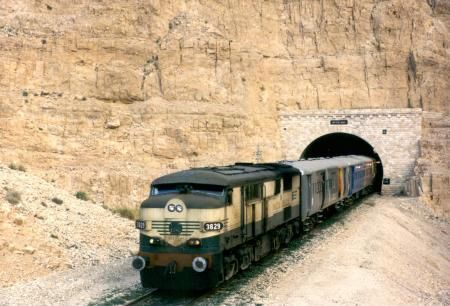 Before leaving Quetta, and in those days (mid – late 1920s), there were no air-conditioned coaches, our mother would be preparing a variety of eatables like cream of wheat candy, the sweet Pinnis made from lentils, various nuts, bazaar made sweetmeats, and hampers of food, selected and cooked in a manner to last without spoiling, the 24 hours that it had to serve. Parathas, meat kababs, minced with onions, egg omelets and something simple as rice pudding for desert. My mother had a horror of eating bazaar cooked food and though the Railways had catering to serve and suit all tastes, she would prefer her own carefully prepared food. For water, too, she would have her own surahi (goblet), which was made of clay to keep the water cold from evaporation, of Quetta spring piped water. We had to carry a number of rolls of bedding, and the canvas “bisterbands†(bed rolls), some new and others held together by devices ingenious in nature, showing clear signs of wear and tear from extended use.
Before leaving Quetta, and in those days (mid – late 1920s), there were no air-conditioned coaches, our mother would be preparing a variety of eatables like cream of wheat candy, the sweet Pinnis made from lentils, various nuts, bazaar made sweetmeats, and hampers of food, selected and cooked in a manner to last without spoiling, the 24 hours that it had to serve. Parathas, meat kababs, minced with onions, egg omelets and something simple as rice pudding for desert. My mother had a horror of eating bazaar cooked food and though the Railways had catering to serve and suit all tastes, she would prefer her own carefully prepared food. For water, too, she would have her own surahi (goblet), which was made of clay to keep the water cold from evaporation, of Quetta spring piped water. We had to carry a number of rolls of bedding, and the canvas “bisterbands†(bed rolls), some new and others held together by devices ingenious in nature, showing clear signs of wear and tear from extended use.
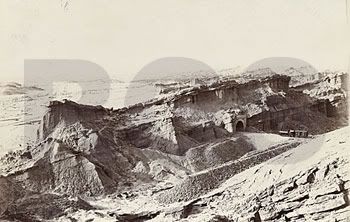 The photo to the left is from the year 1898. It shows the Laleji Plain – Mushkaf-Bolan Railway – Clay hills capped with sandstones and containing layers of same in Baluchistan, Pakistan. Photographer is G.P. Tate and photo is taken from Royal Geographical Society.
The photo to the left is from the year 1898. It shows the Laleji Plain – Mushkaf-Bolan Railway – Clay hills capped with sandstones and containing layers of same in Baluchistan, Pakistan. Photographer is G.P. Tate and photo is taken from Royal Geographical Society.
The Indian Railway system at that time, had four types of accommodation, each higher class costing roughly the double of the lower one. The lowest was IIIrd class, in which no reservation was made and which was not at all furnished except for the provision of wooden benches for sitting. As this was the most crowded and patronized by the poorest and least unspoiled villager, it had the aspect of a menagerie with passengers lying on the decolite covered floor, or if they were aggressive, lying on the bench in disregard of the rights of others. The next was Interclass, patronized mostly by the clerical class, for which it was made as a recognition of the “superiority†of the semi-literate white collar clerical worker over the illiterate laborer. It had rexine mattresses on its benches but that was it. The second and first classes catered toward the upper crust, the former for the paying passenger of the upper middle class and British “other ranksâ€, and the latter almost exclusively for the Civil and Military officers of the upper echelons and the generally nonpaying type, who traveled on passes, as well as concessional half rate Form D passengers. These were made into compartments (large and coupe) with attached lavatories and bathrooms, and had seats convertible at night to sleeping berths. There were exclusive Ladies compartments for each class.
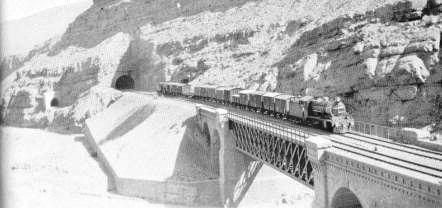
The photo above shows H/G loco working up goods across the famous Elgin Bridge in Dozan Range of Bolan Pass.
Once on the train, we were agog with excitement! There were thousands of distractions on the platform, with hundreds of hands visiting the windows to tempt us with their wares. The din and bustle was enhanced as late passengers would begin arriving, and calls by vendors like ice men and soda water sellers added to our enjoyment, although to the elders it must have been a maddening cacophony. Soon the guard would wave his flag, the driver give out his long whistle to signify lowering of the manual signal and the steam engine would begin rolling with a hiss of steam and a short whistle. The station master, under rules, would sound the departure bell 5 minutes before time.
The Quetta valley is situated at the end of the Bolan Pass, which starts somewhere around halfway between Sibi and Quetta, and ends in Chaman, which faces Afghanistan’s Kandahar. The valley, as most of British Baluchistan, is a plateau surrounded by barren mountains and mostly covered with shingle that comes down with hill torrents. The average altitude is between 4500’ and 6000’ above sea level although certain “peaks†in the terrain may possible touch 7000’. When the train leaves Quetta, it passes through a stretch of slightly rising flatland for about 20 miles to a junction called Spezand, whence the railway lines branches off towards either Mastung, Nushki and right along Lotss Desert to the Iranian outpost of Zahidan (some 350 miles away), or continues along the main line towards Rohri junction in Sind, connecting in the northern direction towards Lahore or the south towards Karachi. As water is only available in rare areas, and that too by an elaborate system of underground channels tapping springs fed by melting snows, one comes across Railway stations named Sar-i-aab (water-head) or Aab-I-gum (lost water). Quetta itself was then liberally fed by water from nearby Hanna and Urak gorges, with open drains carrying the spring water to storage tanks by gravity.
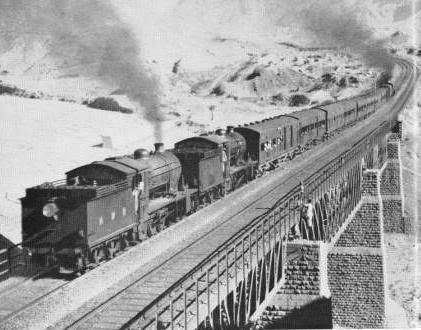
The photo above shows three H/Gs locomotives pushing 53 Up Lahore-Quetta passenger across Bridge 198 over the Nannar Nala through the Bolan Pass.
Beyond Spezand, the double broad guage (5’6â€) line runs straight for a while, all the time increasing in elevation until it takes a turn, into the first of the 20 odd tunnels bored into the layers of hills guarding the Bolan pass before one reaches Aab-i-Gum. On entering Kolpur (5800’), begins the real drama of this train journey. From here begins the winding and dangerous descent, studded with catch siding at short distances to ensure the train speed did not exceed beyond the limt where brakes would fail to operate.
The Kolpur station was flanked by a small village in the valley down below and a sheer mountainside on the other, with just enough space for a small marshalling yard. A gradient of 1 in 21 for the next 15 miles is to be negotiated before one gets to Mach, a small oasis with orange groves, famous for its Central Jail, and from the Railways point of view, for a provision of a third locomotive for trains coming up to Kolpur in the reverse direction. The thrill of winding down this route with tunnels through the mountains and bridges over the Bolan River bed, following in such succession as to give the impression being one continuous chain, cannot be described.
The curves are so short that one can see both the locomotive and guards rear coach from ones window simultaneously. It was risky to look out of the window for more than one reason and normally the glass and gauze panes would be kept closed so that no coal particles from the locomotives chimney got into our eyes. But here, both because of the lessening of the cold due to the lower altitude and the overwhelming desire to keep looking out, those precautions were flouted with occasional ill effects. It speaks wonders for the planners, that the double track that is provided from the very section between Kolpur and Aab-i-Gum (about 50 miles) is a masterpiece of Railway Civil engineering, and it is literally hewn out of the largely yellow clay hills, and at places the passing train almost rubs shoulders with the finely chiseled sheer face of the mountain, and at others, gouged out the body of the mountain are tunnels, in one case up to a mile long, following in such rapid succession that the front of the train is already in the next one before the rear had come out of the previous one.
The road that skirts the hillsides, accompanies the railway tracks most of the way till it parts company after Aab-i-Gum to go to Sibi by a different route. On the way down, Mach is the watershed where we would take tea and cakes served by the Restaurant on the station, whose lessee was a devotee of our father and we always had a special treat. (On our return journey up this section, the speed was at points so slow that one could get down and easily keep pace with the train. To pull these coaches, additional steam engines were attached, the first at Aab-i-Gum at the rear, and it’s a thrilling site to see the puffing locos at each end, their exhausts working in concert, a sort of living rhythm, which in our childish thinking, became synonymous with “Khich Baba, Thak Bacha†(pull grandpa, push son).
From the exit of the Mach station, laid out in a sort of reverse bend, the train seems to change direction and then faces an almost straight upward gradient. To help it along, an additional loco, called a banker, was attached. At Kolpur, the two additional locos are withdrawn as the journey on the Quetta is a slightly downward one. From Sar-i-aab, one can see the Koh-i-Murdar (or dead mountain), in the shadow of which lay Quetta city, with Koh-i-Turtan in the west. One significant feature of the journey back to Quetta is the intrusion of the plains-clothed CID officials, who were always on the lookout for undesirables (including politicians). Till today, when I visit Quetta and look east, I can see by some strange configuration of rock, a man in a white cap on the hum of Koh-i Murdar. I was fascinated and not a little intrigued by this phenomenon. The last sixty five years have not altered this site!.
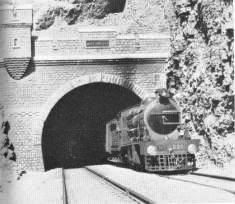 The photo to the left shows 9 up Karachi-Quetta Mail coming out of Mary Jane Tunnel. The tunnel bears the name of the wife of an engineer responsible for the construction of track here.
The photo to the left shows 9 up Karachi-Quetta Mail coming out of Mary Jane Tunnel. The tunnel bears the name of the wife of an engineer responsible for the construction of track here.
The journey in either direction had perforce to be very slow. In the down direction there was a steep gradient and the critical speed for the failure of brakes was 23 MPH, and to keep the driver on his toes, a number of catch sidings were provided, normally set to a siding branching off in the main line, at which the driver had to stop dead and sign a book before the line was reset for his onward journey. Failure to keep the train under control could inevitably lead to disaster to the train as it would lurch over the so called “Jahannum†line, which leads to the top of a crest in the side of the mountain and thereafter a plunge to the ravine below!)
Coming back to the downward journey, Sibi, which one arrived at in the dark, was the official engine changing, watering and cleaning station, and the official dinner stop. It is a sultry, hot place, lying below the sheltered side of the foothills of the Suleiman Range and along with Jacobabad, 70 miles south, has the dubious distinction of being one of the hottest places in the sub-continent with temperatures exceeding 120 degrees in the shade, in summer.
This in spite of its location on the Nari river, mostly a minor stream except when flash flooding caused by the occasional cloud burst in the hills, turns it into a large waterway. (Rain in Baluchistan, except for the Ziarat area, is minimal and as such habitations are few and far in between.). After Sibi, the journey takes one through the sheer desert of Sind, far from the river from which the province takes its name, and the all pervading sand throughout the night keeps getting in imperceptibly, so that when we would get up in the morning, we were coated with sand as was everything else. As 2nd and 1st classes had cooling fans provided, closing the shutters did not make the compartment unbearable.
The photo below shows 10 down Quetta-Karachi Mail crossing a culvert between Tunnel #3 and Tunnel #2 of Mushkaf Range.
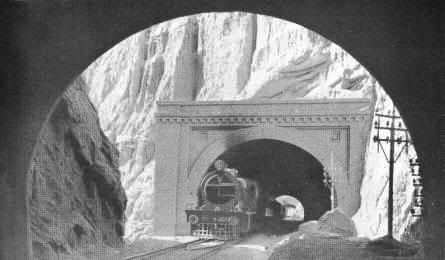
At some point in the early hours of the morning, at Rohri, we would find our coaches detached and moved to the main line junction. Rohri, across the river Indus (which seperates Sukhur from Rohri), is one of the large towns of Sind, whereas Sukkur is mostly a Railway Colony. The twin cities are connected by the Landsdowne Bridge, a cantilever type riveted girder construction nearly a mile long, with each of its stress bearing vertical members rising to about 70’ above the river bed. This bridge was made in the mid-nineteenth century, without the technical masterpieces of bridge engineering. It was quite a while later that the multiple purpose Sukkur Bridge was built across the river Indus, which here runs between a granite lined gorge, and carries both railway and road traffic.
Our coaches would line on a siding at Rohri and a bump would indicate that the express from Karachi had come. A Dining car would also be attached at the same time, and we, who could not do without tea, looked forward to the “Spencers†red turbaned badged bearer coming along with this trays of tea and the usual yellow corn cake. The Train In-charge was the well equipped Guard, with a “Conductor Guard†red arm band indicating his position. He would normally send messages over the Railway Telegraph system in advance for Bet Tea, Breakfast, Lunch, and Dinner in case these had to be served in the compartments. It was later, when I was an officer on the Railways, that I learned what superb fare was also served in the accompanying dining car.
We were rarely required to leave our compartment as all the facilities were provided on the coach. At long halts, some of the elders got out and stretched their legs to buy something or the other, especially in the plains, which we had to cross all day from the time we left Rohri at 7AM and reached Lahore at 7PM. Vendors came to the window of the compartment and we took the opportunity to buy the exotic fruits of the Sind and the Punjab. The “Ganderi†or little peeled cuts of sugarcane, the banana, the oranges and tangerine, and a watery less sweet version called Sangtra, Multan dates and Sohan Halva, Khanpur Khoya or sweetened residue of evaporated milk, or which round cakes were made (peras) and Barfi (silver paper cuts of the same) and so many other delicacies not found in Quetta.
The photo below is courtesy of Agha Waseem Ahmed and shows the approach to cascaded tunnels in Mushkaf Range of Bolan Pass.
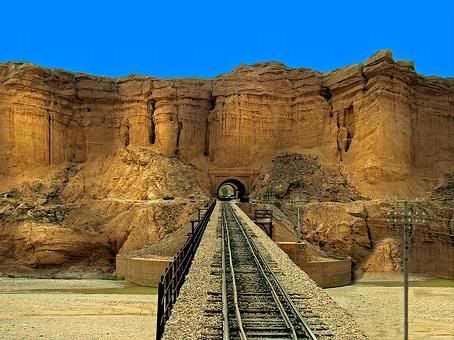
The Karachi Mail was then the crack train of the North Western Railways (NWR). At the time of which I am writing, it ran at the maximum permitted speed of 60 MPH, and halted on the average every 24 miles to suit District/Divisional Headquarters of the Civil Administration and the special Cantonments of the Army. This is what it does even today, only taking a little longer than before. We judged our stops by the fleeting glimpses we got through dust covered window panes of the stations passing by in a swirl of dust or sand, punctuated by the special lurch and “rat a tat†of the wheels of our carriage going over the points of each end of the station; and accompanied by a distinct acceleration in the rhythmic beats of the wheels over joints and a resonant effect.
 One significant feature of the journey through the Sind desert was the distinctive domed thick mud walled station buildings, lined on the outside with the beautifully colored blue clay tiles of that area, designed to keep out the heat (and incidentally, provide shelter for hundreds of pigeons). These were in keeping with the local motif of buildings including shrines. As electricity at that time was not available, kerosene oil lamps were used for station lighting, or for signals. The absence of fans was made up by providing handpulled punkhas (fans). These were wide swathes of cloth fitted on a piece of wood running the width of the rooms, with a rope tied to a hook on the fan, which passed through an opening in the wall to the verandah, where a punkha-puller was there to keep it in motion as long as there was an occupant.
One significant feature of the journey through the Sind desert was the distinctive domed thick mud walled station buildings, lined on the outside with the beautifully colored blue clay tiles of that area, designed to keep out the heat (and incidentally, provide shelter for hundreds of pigeons). These were in keeping with the local motif of buildings including shrines. As electricity at that time was not available, kerosene oil lamps were used for station lighting, or for signals. The absence of fans was made up by providing handpulled punkhas (fans). These were wide swathes of cloth fitted on a piece of wood running the width of the rooms, with a rope tied to a hook on the fan, which passed through an opening in the wall to the verandah, where a punkha-puller was there to keep it in motion as long as there was an occupant.
Though Lahore is itself located in a desert, it has over centuries acquired a distinctly different personality and as one passes Montgomery (100 miles away, now Sahiwal), one enters well tended lands with more and more brick and mortar buildings with a definite urban character.
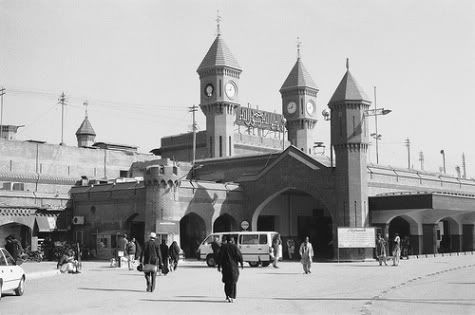
The photo of Lahore station above is courtesy of Sikandarji at flickr.com.
Lahore always awed me with its endless platforms, and imposing Victorian fort-like front, with trains apparently steaming off continuously in all directions possible: Calcutta, Bombay, Delhi. It also ran fast trains to Simla and often more than one fast crack train to the same destination but following a slightly different route. That all this happened in the hours of the evening when our train from Quetta arrived, added to the grandeur. I still believe that in those days it was the best Railway Station in India, and the elite of Lahore, usually promenading the Mall, would often come here at this time to see the bustle of humanity and the moving trains, and also because of its Spencer and Co run Restaurants., which served fare to the delight of any epicurean or gourmet.
Almost a dozen trains left it then and the Railway station was a strong attraction to the residents of Lahore whose simple lives were decidedly enriched by the evening stroll and a dinner on platform number 4. It must be remembered that over sixty years ago, the City of Lahore had only recently begun to acquire breathing spaces in its environs and apart from calling on each other, the only change from the routine lay in “dining out†– a couple of English Hotels (they have since disappeared) was all that was available for this purpose and that too on the Mall, at highly expensive rates. The good inexpensive food on the station was a godsend to all those who could afford to venture out: I think the custom in our heritage of most of the family coming to the station to see one off, had its origin in this desire for an outing; it is only now that there is a tapering off.
Jullander was a major Rail junction, and like all big towns, had a Civil Lines and a Cantonment. Apart from being the hub for a series of small rail spurs served by Diesel rail cars, it was also the terminal of a branch line that led to Ferozepur and then to Raiwind and Lahore via Kapurthala.
Kapurthala state, for its small size, had at least 4 rail stations in its territory, three of them (Kartarpur, Dhilwan, Phagwara) being on the mail line. The white rail coaches for His Highness stood in the siding when he was not using them. We usually dropped off at Kartarpur, short of Jullunder, there being met by someone or the other with a dignified horse-cart. The journey home was nearer from here by 3 miles. The town of Kapurthala was built like any city in Mohallas, or community blocks housing. The separate world of the Maharaja, with his Palace, the Ministers homes, and other Official residences, lifted in miniature from Paris, which he was obsessed with. The Intermediate College and the imposing High Court were in wonderful contrast with the rest of the City’s appearance.
Since those childhood days, I have always enjoyed traveling by train, whenever I could afford the time and leisure, and it has always acted as a shot in the arm. Wordsworth’s heart leapt when he saw a rainbow in the sky; mine still leaps when I see a train go by. Unfortunately, in recent years air travel has largely replaced train travel in most countries, and together with the extensive network of neatly laid out highways, the car has given the Coup de Grace to train and sea travel.
Title Photo Credits:
Title photo is by Agha Waseem Ahmed and shows Jaffar Express traveling between Sibi and Quetta on March 1, 2008.
ATP’s Posts on Pakistan Railway:
1. Khyber Pass Railway
2. Bolan Pass Railway
3. The Trans-Balochistan Railway
4. Changa Manga Forest Railway
5. Lansdowne Bridge, Sukkur
6. Railway Bridge on Indus at Attock
7. Khojak Tunnel
8. Chappar Rift
9. Karachi Circular Railway (KCR)
10. Zhob Valley Railway (ZVR)
11. How the First Locomotive Reached Lahore
12. 3000hp Iron Horses of Pakistan
13. Karachi Tramway of Yesteryears
14. Lahore Rapid Mass Transit Rail Project
15. A Phoenix Rises From the Ashes of Bakhshapur
16. ek masla hai… A Railway Runs Through It
17. Ava Gardner in Lahore for Bhowani Junction
18. The Meter-Gauge of Sindh
19. Indus Flotilla Company
20. Karachi to Kotri: First Railways in Pakistan
21. Pakistan Railway on the West Bank of Indus
22. SPS#3157: Pakistan’s Gift to the People of Britain
Pakistan Railway Discussion Group:
If you want to learn more about Pakistan Railways, then feel free to join the ‘Pakistan Railway (PR)’ discussion group. Everything and anything related to PR is discussed here e.g. preserving of Pakistan’s rail heritage, steam locomotives, sharing of photos and news, time tables etc. You can join the discussion group here.



















































And there you go, the very best GTA 5 Mods.
Shooting games: Games that are normally first individual shooters,
or other workforce based shooting recreation.
Hi.
I want to tell you that I’musing this site for some time and you
write very good content. I shared your newset article
on tumblr and got a llot off positive feedbacks.
Waiting for your next article
Very good post! We will be linking to this particularly
great content on our site. Keep up the great writing.
Hi, yup this article is in fact nice and I have learned lot of things from
it concerning blogging. thanks.